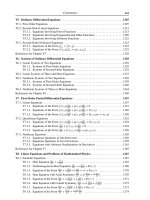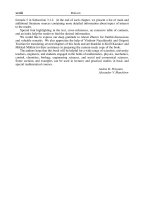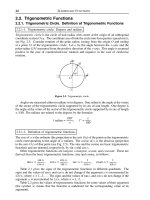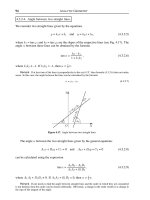Handbook of mathematics for engineers and scienteists part 15 pot
Bạn đang xem bản rút gọn của tài liệu. Xem và tải ngay bản đầy đủ của tài liệu tại đây (416.75 KB, 7 trang )
66 ELEMENTARY GEOMETRY
TABLE 3.4
Regular polyhedra (a is the edge length)
No. Name
Number of faces
and its shape
Number
of vertices
Number
of edges
Total surface area Vo l u m e
1
Tetrahedron
4 triangles
4 6
a
2
√
3
a
3
√
2
12
2
Cube
6 squares
8 12
6a
2
a
3
3
Octahedron
8 triangles
6 12
2a
2
√
3
a
3
√
2
3
4
Dodecahedron
12 pentagons
20 30
3a
2
25 + 10
√
5
a
3
4
(15 + 7
√
5)
5
Icosahedron
20 triangles
12 30
3a
2
√
3
5a
3
12
(3 +
√
5)
l
H
()a
()b
Figure 3.32. A cylindrical surface (a). A cylinder (b).
the generator, then the lateral surface area S
lat
and the volume V of the cylinder are given
by the formulas
S
lat
= PH = P
sec
l,
V = S
bas
H = S
sec
l.
(3.2.3.1)
In a right cylinder, the bases are perpendicular to the generator. In particular, if the
bases are disks, then one speaks of a right circular cylinder. The volume, the lateral surface
area, and the total surface area of a right circular cylinder are given by the formulas
V = πR
2
H,
S
lat
= 2πRH,
S = 2πR(R + H),
(3.2.3.2)
where R is the radius of the base.
A right circular cylinder is also called a round cylinder,orsimplyacylinder.
2
◦
. The part of a cylinder cut by a plane nonparallel to the base is called a truncated cylinder
(Fig. 3.33a).
The volume, the lateral surface area, and the total surface area of a truncated cylinder
3.2. SOLID GEOMETRY 67
H
H
2
1
R
h
b
φ
2a
R
R
()a
()b ()c
H
r
R
Figure 3.33. A truncated cylinder (a), a “hoof” (b), and a cylindrical tube (c).
are given by the formulas
V = πR
2
H
1
+ H
2
2
,
S
lat
= πR(H
1
+ H
2
),
S = πR
H
1
+ H
2
+ R +
R
2
+
H
2
– H
1
2
2
,
(3.2.3.3)
where H
1
and H
2
are the maximal and minimal generators.
3
◦
.Asegment of a round cylinder (a “hoof”) is a portion of the cylinder cut by a plane that
is nonparallel to the base and intersects it. If R is the radius of the cylindrical segment, h is
the height of the “hoof,” and b is its width (for the other notation, see Fig. 3.33b), then the
volume V and the lateral surface area S
lat
of the “hoof” can be determined by the formulas
V =
h
3b
a(3R
2
– a
2
)+3R
2
(b – R)α
=
hR
3
b
sin α –
sin
3
α
3
– α cos α
,
S
lat
=
2πR
b
[(b – R)α + a],
(3.2.3.4)
where α =
1
2
ϕ is measured in radians.
4
◦
. A solid bounded by two closed cylindrical surfaces and two planes is called a cylindrical
tube; the planes are called the bases of the tube. The volume of a round cylindrical tube
(Fig. 3.33c)is
V = πH(R
2
– r
2
)=πHδ(2R – r)=πHδ(2r + δ)=2πHδρ,(3.2.3.5)
where R and r are the outer and inner radii, δ = R – r is the thickness, ρ =
1
2
(R + r)isthe
midradius, and H is the height of the pipe.
3.2.3-2. Conical surface. Cone. Frustum of cone.
A conical surface is the union of straight lines (generators) passing through a fixed point
(the apex) in space and any point of some space curve (the directrix) (Fig. 3.34a).
68 ELEMENTARY GEOMETRY
H H
l
R
h
r
l
R
()a
()b ()c ()d
Figure 3.34. Conical surface (a). A cone (b), a right circular cone (c), and a frustum of a cone (d).
1
◦
. A solid bounded by a conical surface with closed directrix and a plane is called a cone;
the plane is the base of the cone (Fig. 3.34b). The volume of an arbitrary cone is given by
the formula
V =
1
3
HS
bas
,(3.2.3.6)
where H is the altitude of the cone and S
bas
is the area of the base.
A right circular cone (Fig. 3.34c) has a disk as the base, and its vertex is projected onto
the center of the disk. If l is the length of the generator and R is the radius of the base, then
the volume, the lateral surface area, and the total surface area of the right circular cone are
given by the formulas
V =
1
3
πR
2
H,
S
lat
= πRl = πR
√
R
2
+ H
2
,
S = πR(R + l).
(3.2.3.7)
2
◦
. If a cone is cut by a plane parallel to the base, then we obtain a frustum of a cone
(Fig. 3.34d). The length l of the generator, the volume V , the lateral surface area S
lat
,and
the total surface area S of the frustum of a right circular cone are given by the formulas
l =
h
2
+(R – r)
2
,
V =
πh
3
(R
2
+ r
2
+ Rr),
S
lat
= πl(R + r),
S = π[l(R + r)+R
2
+ r
2
],
(3.2.3.8)
where r is the radius of the upper base and h is the altitude of the frustum of a cone.
3.2.3-3. Sphere. Spherical parts. Torus.
1
◦
.Thesphere of radius R centered at O is the set of points in space at the distance R
from the point O (Fig. 3.35a). A solid bounded by a sphere is called a ball. Any section
of the sphere by a plane is a circle. The section of the sphere by a plane passing through
its center is called a great circle of radius R. There exists exactly one great circle passing
through two arbitrary points on the sphere that are not antipodal (i.e., are not the opposite
endpoints of a diameter). The smaller arc of this great circle is the shortest distance on the
sphere between these points. Concerning the geometry of the sphere, see Section 3.3. The
3.2. SOLID GEOMETRY 69
surface area S of the sphere and the volume V of the ball bounded by the sphere are given
by the formulas
S = 4πR = πD
2
=
3
√
36πV
2
,
V =
4πR
3
3
=
πD
3
6
=
1
6
S
3
π
,
(3.2.3.9)
where D = 2R is the diameter of the sphere.
R
R
2a
h
R
2a
h
()a
()b ()c
Figure 3.35. A sphere (a), a spherical cap (b), and a spherical sector (c).
2
◦
. A portion of a ball cut from it by a plane is called a spherical cap (Fig. 3.35b). The
width a, the area S
lat
of the curved surface, the total surface area S, and the volume V of a
spherical cap can be found from the formulas
a
2
= h(2R – h),
S
lat
= 2πRh = π(a
2
+ h
2
),
S = S
lat
+ πa
2
= π(2Rh + a
2
)=π(h
2
+ 2a
2
),
V =
πh
6
(3a
2
+ h
2
)=
πh
2
3
(3R – h),
(3.2.3.10)
where R and h are the radius and the height of the spherical cap.
3
◦
. A portion of a ball bounded by the curved surface of a spherical cap and the conical
surface whose base is the base of the cap and whose vertex is the center of the ball is called
a spherical sector (Fig. 3.35c). The total surface area S and the volume V of a spherical
sector are given by the formulas
S = πR(2h + a),
V =
2
3
πR
2
h,
(3.2.3.11)
where a is the width, h is the height, and R is the radius of the sector.
4
◦
. A portion of a ball contained between two parallel plane secants is called a spherical
segment (Fig. 3.36a). The curved surface of a spherical segment is called a spherical zone,
and the plane circular surfaces are the bases of a spherical segment. The radius R of the
ball, the radii a and b of the bases, and the height h of a spherical segment satisfy the relation
R
2
= a
2
+
a
2
– b
2
– h
2
2h
2
.(3.2.3.12)
70 ELEMENTARY GEOMETRY
The curved surface area S
lat
, the total surface area S, and the volume V of a spherical
segment are given by the formulas
S
lat
= 2πRh,
S = S
lat
+ π(a
2
+ b
2
)=π(2Rh + a
2
+ b
2
),
V =
πh
6
(3a
2
+ 3b
2
+ h
2
).
(3.2.3.13)
R
r
R
2a
2b
(a)(b)(c)
h
R
2a
2b
h
Figure 3.36. A spherical segment (a) and a spherical segment without the truncated cone inscribed in it (b).
A torus (c).
If V
1
is the volume of the truncated cone inscribed in a spherical segment (Fig. 3.36b)
and l is the length of its generator, then
V – V
1
=
πhl
2
6
.(3.2.3.14)
4
◦
.Atorus is a surface generated by revolving a circle about an axis coplanar with the
circle but not intersecting it. If the directrix is a circle (Fig. 3.36c), the radius R of the
directrix is not less than the radius r of the generating circle (R ≥ r), and the center of the
generator moves along the directrix, then the surface area and the volume of the torus are
given by the formulas
S = 4π
2
Rr = π
2
Dd,
V = 2π
2
Rr
2
=
π
2
Dd
2
4
,
(3.2.3.15)
where D = 2R and d = 2r are the diameters of the generator and the directrix.
3.3. Spherical Trigonometry
3.3.1. Spherical Geometry
3.3.1-1. Great circle.
A great circle is a section of a sphere by a plane passing through the center.
Properties of great circles:
1. The radius of a great circle is equal to the radius of the sphere.
2. There is only one great circle through two arbitrary points that are not the opposite
endpoints of a diameter.
The smaller arc of the great circle through two given points is called a geodesic,andthe
length of this arc is the shortest distance on the sphere between the two points. The great
circles on the sphere play a role similar to the role of straight lines on the plane.
3.3. SPHERICAL TRIGONOMETRY 71
Any two points on the sphere determine a pencil of planes. The intersection of each
plane in the pencil with the sphere is a circle. If two points are not the opposite endpoints
of a diameter, then the plane passing through the center of the sphere determines the largest
circle in the pencil, which is a great circle. The other circles are called small circles;the
intersection with the sphere of the plane perpendicular to the plane containing the great
circle is the smallest circle.
3.3.1-2. Measurement of arcs and angles on sphere. Spherical biangles.
The distances on the sphere are measured along great circle arcs. The great circle arc length
between points A and B is given by the relation
AB = Rα,(3.3.1.1)
where R is the radius of the sphere and α is the corresponding central angle (in radians).
If only the unit sphere (the radius R = 1) is considered, then each great circle arc can
be characterized by the corresponding central angle (in radians). The angle between two
intersecting great circle arcs is measured by the linear angle between the tangents to the
great circles at the point of intersection or, which is the same, by the dihedral angle between
the planes of the great circles.
Two intersecting great circles on the sphere form four spherical biangles. The area of a
spherical biangle with the angle α is given by the formula
S = 2R
2
α.(3.3.1.2)
3.3.2. Spherical Triangles
3.3.2-1. Basic notions and properties.
A figure formed by three great circle arcs pairwise connecting three arbitrary points on
the sphere is called a spherical triangle (Fig. 3.37a). The vertices of a spherical triangle
are the points of intersection of three rays issuing from the center of the sphere with the
sphere. The angles less than π between the rays are called the sides a, b,andc of a spherical
triangle. Such spherical triangles are called Euler triangles. To each side of a triangle there
corresponds a great circle arc on the sphere. The angles α, β,andγ opposite the sides a,
b,andc of a spherical triangle are the angles between the great circle arcs corresponding
to the sides of the triangle, or, equivalently, the angles between the planes determined by
these rays.
a
a
(b)(a)
α
α
b
b
c
c
β
β
γ
γ
Figure 3.37. A spherical triangle.
72 ELEMENTARY GEOMETRY
By analogy with the circumcircle of a plane triangle, there is a “circumscribed cone of
revolution” that contains the three straight lines determining the triangle; the axis of this
cone is the intersection of the planes perpendicular to the sides at their midpoints. There
also exists an “inscribed cone of revolution” that is tangent to the three planes corresponding
to the spherical triangle; the axis of this cone is the intersection of the angle bisector planes.
The “circumradius”
R and the “inradius” r are defined as the angles equal to half the angles
at the vertices of the first and the second cone, respectively.
If R is the radius of the sphere, then the area S of the spherical triangle is given by the
formula
S = R
2
ε,(3.3.2.1)
where ε is the spherical excess defined as
ε = α + β + γ – π (3.3.2.2)
and measured in radians.
A spherical triangle is uniquely determined (up to a symmetry transformation) by:
1. Three sides.
2. Three angles.
3. Two sides and their included angle.
4. Two angles and their included side.
Let α, β,andγ be the angles and a, b,andc the sides opposite these angles in a spherical
triangle (Fig. 3.37b). Table 3.5 presents the basic properties and relations characterizing
spherical triangles (with the notation 2p = a + b + c and 2P = α + β + γ – π). From the
relations given in Table 3.5, one can derive all missing relations by cyclically permuting the
sides a, b,andc and the angles α, β,andγ.
L
EGENDRE’S THEOREM.
The area of a spherical triangle with small sides (i.e., with sides
that are small compared with the radius of the sphere) is approximately equal to the area of
a plane triangle with the same sides; the difference between each angle of the plane triangle
and the corresponding angle of the spherical triangle is approximately equal to one-third of
the spherical excess.
The law of sines, the law ofcosines, and the half-angletheorem in spherical trigonometry
for small sides become the corresponding theorems of the linear (plane) trigonometry.
Table 3.6 allows one to find the sides and angles of an arbitrary spherical triangle if
three appropriately chosen sides and/or angles are given.
3.3.2-2. Rectangular spherical triangle.
A spherical triangle is said to be rectangular if at least one of its angles, for example, γ,is
equal to
1
2
π (Fig. 3.38a); the opposite side c is called the hypotenuse.
a
(a)(b)
α
b
c
π
2
β
a
b
α
c
π
π
2
2
β
Figure 3.38. A rectangular spherical triangle (a). The Neper rules (b).









